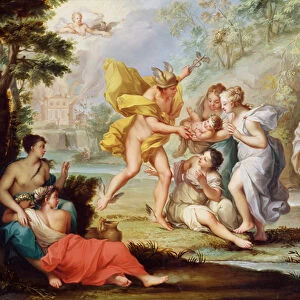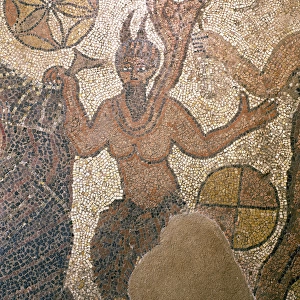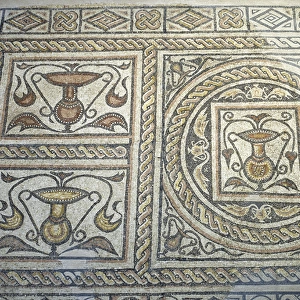Triton and a sea creature, Roman mosaic
![]()

Wall Art and Photo Gifts from Science Photo Library
Triton and a sea creature, Roman mosaic
Roman mosaic showing Triton and a sea creature. Detail from an ancient mosaic from Otricoli, Umbria, Italy, now stored in the Vatican Museums. Triton (right) was the messenger of the deep seas, and son of Neptune (god of the sea). Triton is shown here with a sea animal (left). In Roman mythology, Tritons special attribute was a twisted conch shell which he blew like a trumpet to calm or raise the waves. Its sound was so terrible, it was said to scare away the giants, who thought it was the roar of a mighty wild beast
Science Photo Library features Science and Medical images including photos and illustrations
Media ID 6367263
© SHEILA TERRY/SCIENCE PHOTO LIBRARY
Ancient Antiquity Archaeological Archaeology Archeological Archeology Architecture Classical Deity Divine Immortal Italian Italy Mosaic Mythological Mythology Pagan Religion Religious Roman Rome Triton Vatican Museum Vatican Museums Merman Otricoli Sea Animal
EDITORS COMMENTS
This print showcases a stunning Roman mosaic depicting Triton, the messenger of the deep seas, and a mysterious sea creature. The intricate detail from this ancient artwork, now housed in the Vatican Museums, transports us back to classical times in Italy's Umbria region. Triton, positioned on the right side of the mosaic, stands as a symbol of power and authority. As Neptune's son and god of the sea himself, he exudes an air of divine presence. His twisted conch shell trumpet rests at his side—a unique attribute that allowed him to manipulate ocean waves with its haunting sound. On Triton's left side lurks an enigmatic sea animal whose identity remains shrouded in mythological mystery. This creature adds an element of intrigue and wonder to the scene, leaving viewers captivated by its unknown origins. In Roman mythology, Triton's conch shell was so powerful that even giants were terrified by its roar. Its echoes resembled those produced by mighty wild beasts—an auditory spectacle capable of calming or raising tempestuous waters. Through this remarkable piece of artistry preserved through time and discovered through archaeological efforts, we are reminded not only of Rome's rich history but also humanity's fascination with deities and mythical creatures. It serves as a testament to our enduring curiosity about ancient civilizations' beliefs and their artistic expressions thereof.
MADE IN THE USA
Safe Shipping with 30 Day Money Back Guarantee
FREE PERSONALISATION*
We are proud to offer a range of customisation features including Personalised Captions, Color Filters and Picture Zoom Tools
SECURE PAYMENTS
We happily accept a wide range of payment options so you can pay for the things you need in the way that is most convenient for you
* Options may vary by product and licensing agreement. Zoomed Pictures can be adjusted in the Cart.













